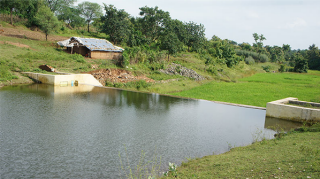Rainwater Harvesting System in India
Helping the farmers with Rainwater Harvesting techniques
India is an agriculture-based country where 70% of the economy comes from the primary sector: farming. As intensive agriculture is spreading across India, there is an urgent need to encourage rainwater harvesting for irrigation. Nearly 60 % of farmers of the country depend on monsoons for agriculture due to the dearth of sustainable water resources. The erratic rain pattern was disturbing the livelihood of the cultivators. To address the issue a scientific water conversation technique named rainwater harvesting was introduced.
What is Rainwater Harvesting?
Rainwater harvesting is a technique where the rainwaters are collected into natural reservoirs, tanks or made to infiltrate the surface waters via subsurface aquifers. Rainwater harvesting is a simple easy and cost-effective technique that can be set up in open farming fields to collect and use the rainwater for irrigating crops.
During the past three decades, the demand for irrigation has shot up. Farmers are harvesting multiple crops. Therefore, a systematic and scientific approach for conserving the water was necessary and rainwater harvesting turned out to be the best solution. This water conservation technique is being encouraged in critical sectors of the economy like agriculture due to the increasing demand for the irrigation and growing concerns of water scarcity.
HCCB and Rainwater Harvesting
Villages of Betul district Madya Pradesh faced severe water crisis due to the erratic rainfall patterns. To address the issue the villagers approached HCCB through a local NGO-Advancement for Social Action (ASA) for a solution.
HCCB soon spun into action with its team to set up a permanent solution to conserve water in the local areas. To help the villagers farm their land and feed their families HCCB developed many water stewardships programs. Under the integrated watershed management project, HCCB took up various conservative measures. HCCB in association of local authorities built 28 farm ponds and 35 masonry stop dams within a brief period of 24 months.
Furthermore, HCCB in partnership with NGO-ASA developed a five-year action plan to address the water scarcity in the surrounding villages. The five-year target was to improve the availability of the water for drinking, farming and other purposes in the local habitats. Additionally, the project was taken up to enhance the lives of the local community by encouraging monsoon dependent farming.
The excessive drilling of the borewells and wells resulted in depletion the groundwater in the local villages. So, HCCB used this opportunity to educate the local community about the importance of recharging of the depleting groundwater resource with rainwater harvesting.
Today nearly about 5000 families across the 38 villages are being benefitted by the sustainable water conservation techniques. The local farmers are reaping the results of rainwater harvesting measures taken by HCCB. HCCB in association with different NGOs take up such sustainable farming techniques to bring cheers in the lives of farmers who lack enough irrigation facilities and helped them to earn their living.




Comments
Post a Comment